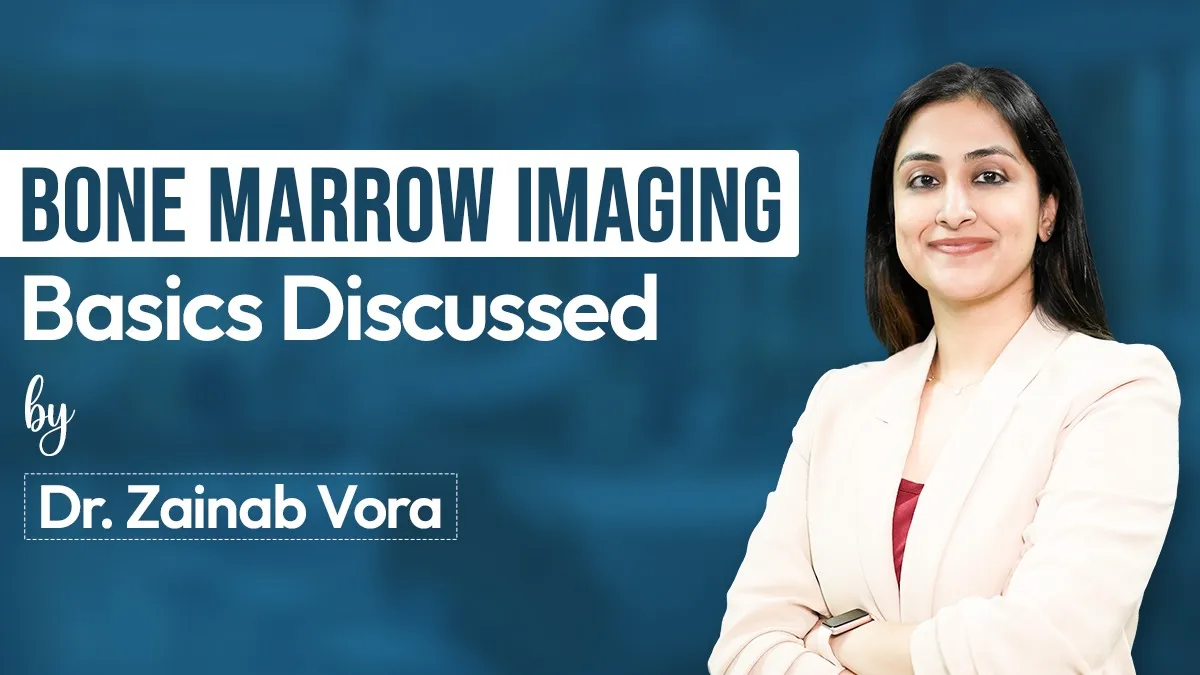
Bone Marrow Imaging Basics Discussed by Dr. Zainab Vora
Estimated reading time: 3 minutes
Bone marrow imaging is an integral part of radiology, especially for radiology residents who want to expand their knowledge in musculoskeletal imaging. In her insightful session on the Conceptual Radiology App, Dr. Zainab Vora explains the basic principles of bone marrow anatomy and imaging so that radiology residents can easily understand complex concepts.
Understanding Bone Marrow Composition
To understand bone marrow imaging, it is essential first to know its anatomy. Bone has two primary components:
- Cortical Bone: Dense and hypo-intense on all MRI sequences.
- Cancellous (Trabecular) Bone: Has bone marrow, which has variable signal intensity because of its varying composition.
Bone marrow consists of:
- Red Marrow: High in hematopoietic cells
- Yellow Marrow: Mostly fat
- Osseous Components and Supporting Structures
A pathology sample of bone marrow shows trabeculae interspersed with cells and fat. As we age, hematopoietic cells are replaced by fat, converting red marrow to yellow marrow.
Bone Marrow and MRI Signal Intensity
MRI is the imaging gold standard for bone marrow. T1 and STIR sequence understanding is important:
Yellow Marrow
- 80% fat, 15% water, 5% protein
- T1: Hyperintense (like subcutaneous fat)
- STIR: Suppressed (fat suppression technique)
Red Marrow
- 40% fat, and hematopoietic cells and water
- T1: Intermediate signal intensity (not strictly hypo-intense as originally supposed)
- STIR: Intermediate (not totally suppressed because of fat content)
- Comparison: Always slightly hyperintense compared to muscle or intervertebral disc
Age-Related Changes in Bone Marrow
Marrow conversion takes certain patterns:
- Distal to Proximal Conversion
- Commences in hands and feet, proceeding toward the limbs and then the axial skeleton.
- Inside a bone, it begins at the diaphysis and then continues to the metaphysis.
- Exception: Epiphysis and apophysis are filled with yellow marrow right from the start.
- Age-wise Conversion Sequence
- Infants: The whole skeleton is red marrow (low T1 signal).
- Children: Epiphyses ossify and get converted to yellow marrow first.
- Adolescents: Yellow marrow replaces red marrow in the diaphysis.
- Adults: Conversion is to the metaphysis, where proximal femoral and humeral metaphysis preserve red marrow until older adulthood (40-50 years in some individuals).
Patterns in the Spine
In adults, marrow conversion in the spine occurs in variable but recognizable patterns:
- Fatty marrow becomes visible along basal vertebral veins.
- Early conversion is seen in peripheral endplates.
- Unorganized patterns of conversion can also be noted.
Why Bone Marrow Imaging Matters?
It is important to understand bone marrow structure and MRI features to detect such pathologies as leukemia, anemia, and marrow infiltration. Following these basic principles, radiology residents can interpret MRI scans confidently and diagnose conditions correctly.
Learn More on Conceptual Radiology
This bone marrow imaging session by Dr. Zainab Vora is just an overview of the extensive learning that you can obtain on Conceptual Radiology. With detailed sessions, live lectures, and case discussions, you will have a strong foundation in radiology. Stay focused, continue learning, and subscribe to Conceptual Radiology to ace our radiology residency!
